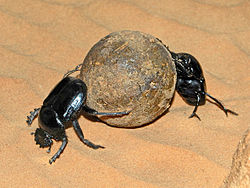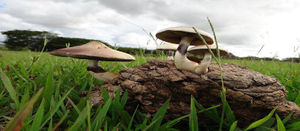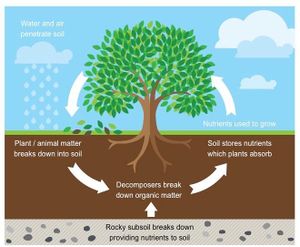Coprophagia
Definition
Coprophagia or Coprophagy are terms associated with the act of consuming feces. The word is derivative of the Greek κόπρος (copros), "feces" and φαγεῖν (phagein), "to eat". Coprophagy comes in many different flavors; heterospecifics consume the feces of other species, allocoprophagy is the consumption of the feces of an individual of the same species and autocoprophagy is the consumption of one's own feces. It is typical of some animal species to eat feces, lagomorphs do so to allow tough plant material to digest more efficiently via two passages through the digestive tract. Other species may eat feces under specific behavioral conditions that are beneficial to the species, its symbiont and the surrounding environment. Coprophagous organisms are geographically and morphologically diverse and consist of mega-, macro-, and mesofauna.

Invertebrates
Coprophagous insects of the Hexapod group of the Arthropoda phylum, consume and digest the feces of larger species, such as mammals, because they have digestive tracts of lesser efficiency when it comes to breaking down nutrients in foods and making them biologically available for further uptake by plants or animals. In isopods, the inability to absorb nutrients from food in the posterior hindgut has been considered one reason for coprophagy [5]. When given the choice, isopods will participate in allocoprophagy or autocoprophatgy. The consumption of feces by isopods is thought to be linked to a deficiency in copper concentrations in the body due to the lack of availability of copper in leaf litter. Some species of flies and Dung Beetles are known to be coprophagic, they feed on the microorganism-rich excrement of other species. Dung Beetles make balls of dung by rolling them, they then bury the balls underground and lay there eggs within it.
A common temporary resident in the soils of temperate deciduous forests, the Hawthorn fly is plays an important role in leaf litter decomposition and exploits the rich resources in the feces of other soil organisms as another source of food [1]. Some coprophagic earthworms' affinity for feces enriched soil make them important disseminators of some microbial pathogens such as T. gondii [2].

Coprophilous Fungi
Coprophilous Fungi such as species Cheilymenia are a type of saprobic ascomycete that feed and grow on the animal dung. The species of this group of fungi can be highly specialized and prefer the dung of one species of herbivore, or they may be generalized and not prefer any one type of herbivore dung. The spores of this fungi are unwittingly consumed by animals from vegetation, then excreted with the plant matter. These fungi often have thick-walled, pigmented spores that require passage through an animal digestive tract to begin germination [7]. The fruiting bodies, or mushrooms, of these fungi can be seen on top of dung piles. What is most interesting is that there exist vast mycelial networks within the dung piles that allow for the succession of the fruiting bodies. Psilocybe, Panaeolus, and Coprinus species are also sometimes found growing out of dung [3]. Fossils of certain coprophilous fungi species have been used by archaeologists to determine which types of animals were being domesticated around the initial forest disturbances by humans in the early Holocene deposits [7].

Nutrient Cycling
Coprophagous organisms can help an ecosystem cycle nutrients by breaking down materials that are not yet biologically available to plants for uptake and use. Biological aging or scenescence is the gradual deterioration of the functional characteristics of organic material, it results in the loss of nutrients to the environment. While the scope of importance of coprophagy in the field is not yet known, it is postulated that coprophagy by saprophagous soil animals that preferentially feed on the feces of phytophagous insects may add a further trophic level to soil–plant–animal interactions and increase the diversity of involved processes [6]. It is also suggested that nutrients are released faster by the feces of phytophagous insects than by leaf litter and that coprophagy by isopods may contribute to fast cycling of nutrients in the growing season of deciduous forests. It is suggested that nutrients released by coprophagous isopods may contribute to the regrowth by defoliated trees [6]. One study has found that the presence of coprophagous isopods resulted in an increase in both Calcium concentration and the C:N ratio of soils while deacreasing Potassium and Magnesium concentrations in soils over a twelve week period [6].
Coprophagous soil arthropods such as the Porcelio scaber isopod can increase nutrient release from animal frass and leaf litter via multiple digestions of the organic material [4]. The activity and respiration of soil microbes has been shown to increase in the presence of coprophagous detritivores in experimental settings [4]. Microbial inoculated feces represent microbial 'hotspots' in soil, they create gradients along airborne microbial metabolites that may attract foraging coprophagous isopods to the microbial hotspot [5]. Due to their feeding activity, terrestrial isopods contribute to decomposition processes by breaking down leaf litter and by promoting microbial activity. By ingesting their own feces which have been colonized by bacteria, the isopods can benefit from the presence of the microbes in their gut. The presence of such microbes in the gut helps the isopods to further absorb nutrients and then pass them into the soil [5].
References
1. Špaldoňová, A. 2014. The role of soil microfauna in organic matter decomposition and stabilization. Charles University in Prague: Faculty of Science: 18-22. [1]
2. Bettiol, S. S., D. L. Obendorf, M. Nowarkowski, T. Milstein, J. M. Goldsmid. 2000. Earthworms as Paratenic Hosts of Toxoplasmosis in Eastern Barred Bandicoots in Tasmania. Journal of Wildlife Diseases Volume 36: 145-148. [2]
3. Lepp, H. 2013. Information about Australia's Flora. Australian Fungi. Fungal Ecology. Dung Fungi. <https://www.anbg.gov.au/fungi/ecology-dung.html>. Downloaded on 21 April 2019. [3]
4. Madritch, M. D., J. R. Donaldson, R. L. Lindroth. 2007. Canopy herbivory can mediate the influence of plant genotype on soil processes through frass deposition. Soil Biology and Biochemistry Volume 39: 1192-1201. [4]
5. Zimmer, M. 2002. Nutrition in terrestrial isopods (Isopoda: Oniscidea): An evolutionary-ecological approach. Biological Reviews Volume 77: 455-593. [5]
6. Zimmer, M., W. Topp. 2002. The role of coprophagy in nutrient release from feces of phytophagous insects. Soil Biology and Biochemistry Volume 34: 1093-1099. [6]
7. López-Sáez, J. A., L. López-Merino. 2007. Coprophilous fungi as a source of information of anthropic activities during the Prehistory in the Amblés Valley (Ávila, Spain): The archaeopalynological record. Revista Española de Micropaleontología Volume 39: 103-116. [7]
8. Millipede. (n.d.). . Rottler Pest & Lawn Solutions. [8]
9. Image 5. 2017. . EL ESCARABAJO VERDE DE PHILIPP VANDENBERG: ENTRE LA REALIDAD Y LA FICCIÓN. FUNDACIÓN ENTOMOLÓGICA ANDINA. [9]
10. Psilocybe cubensis. 2019. . Truffle Magic Blog. [10]
11. Nutrient Cycling. 2018. . Alpha Nutrient. [11]